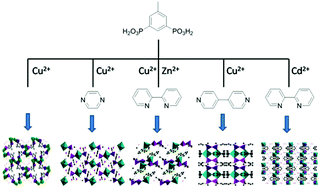Speciation of metal phosphonates with the assistance of weak interactions†
Abstract
By employing an aromatic methyl substituted V-shaped diphosphonic acid as a ligand, a series of metal diphosphonates, namely [Cu3(HL)2(H2O)2][(H2O)2] (1), [Cu(H2L)(pyz)(H2O)2][(H2O)2] (2), [Cu(H2L)(2,2′-bipy)] (3), [Cu(H2L)(4,4′-bipy)(H2O)2] (4), [Zn(H2L)(2,2′-bipy)] (5) and [Cd(H2L)(2,2′-bipy)(H2O)][(H2O)6] (6), have been synthesized. The structural studies reveal that these compounds exhibit diverse crystal structures. The introduction of the methyl group and pyridine derived auxiliary ligands results in the formation of plenty of C–H⋯O, C–H⋯π and π⋯π interactions, which contribute to the crystallization of metal diphosphonates. It was found that the Zn and Cd containing compounds showed intense intraligand emissions.


 Please wait while we load your content...
Please wait while we load your content...